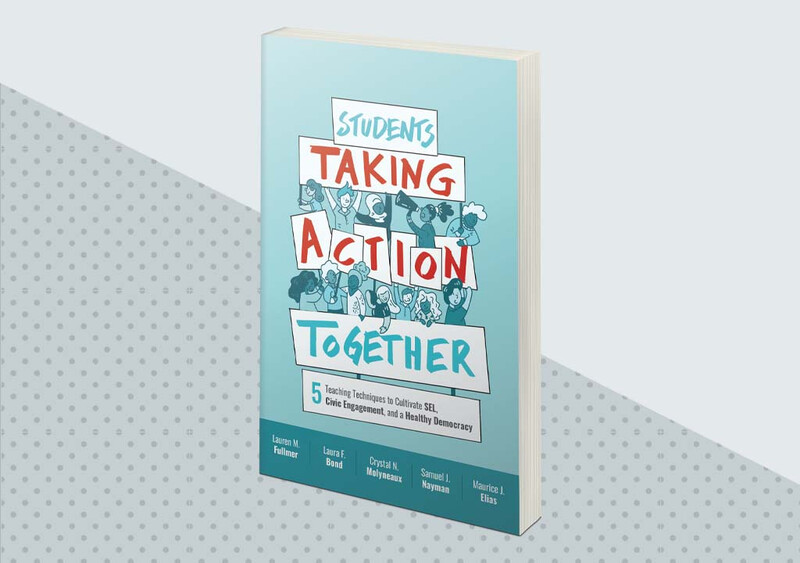With the lingering effects of the pandemic, school districts responding to polarized concerns over critical race theory, and states rolling back freedom of speech in the classroom, teachers’ abilities to engage in discussions of critical topics in the classroom are eroding. Some educators are leaving the profession, while others avoid any topic that might get pushback. Consequently, these conditions foster school climates defined by conformity and compliance.
In such environments, students' mental health and wellness suffer. Students must grapple with living in a tense and jarring reality—one in which racial injustice and the climate emergency are at a tipping point—that is neither explored nor examined critically in their schools. Perhaps the most troubling long-term impact is that citizenship skills are undermined. The Teaching Engaged Citizenship Act, introduced by Rep. Scanlon (D-PA) in September 2021, underscores the need to expand teaching civics and citizenship in schools.
Taking Action Together
Ultimately, students need strategies that guide them in how to think about social issues, both current and historical, while not telling them what to think about those issues. Students also need the basic life skills to engage in classroom discussion, and peer and personal inquiry about such issues. The Students Taking Action Together (STAT) project of Rutgers University, led by Maurice Elias, satisfies the quandary of how schools can prepare educators to integrate civil discourse and social-emotional learning while meeting academic standards.
STAT guides teachers to implement five strategies: norms, Yes-No-Maybe, respectful debate, audience-focused communication, and PLAN (a social problem-solving strategy). Together, with coauthors Crystal Molyenuex and Samuel Nayman, we developed lesson plans that embed the five strategies. (For more, see our new ASCD book Students Taking Action Together.) The strategies can be applied to all academic disciplines; they provide a powerful way for teachers to support healthy civil discourse and civic action while explicitly teaching social-emotional skills required for democratic citizenship.
1. Norms: Attune the Classroom Culture for Safe Expression
As teachers approach norms, laying the groundwork for student safety and security is the first step to creating an environment for expressive risk-taking. Co-creating expectations for learning as a classroom community fosters the psychological safety for open dialogue and peer opinion sharing. Some expectations that might be helpful are “share the airtime,” “be present,” and “no cell phones,” which hold students accountable for being present in learning. Creating norms also engage students in the SEL competencies of responsible decision-making and relationship skills, as they work together as a classroom community.
Ultimately, students need strategies that guide them in how to think about social issues, both current and historical, while not telling them what to think about those issues.
2. Yes-No-Maybe: Get Comfortable with Peer Opinion Sharing
Expressing and justifying opinions on public issues is a formative democratic activity. With norms in place, the Yes-No-Maybe strategy helps students share their views on social issues, controversial decisions, and issues impacting their school community. Bringing democratic discourse alive, students respond using “Yes,” “No,” or “Maybe” to a series of statements drawn from a source on a topic that is unsettled, contentious, debatable, or has no clear solution, like combating racism, addressing the climate emergency, or abating gun violence.
At first, the students aren’t exposed to the source when they share their opinions. After reading the source, students revisit the statements they made, making any changes to their original opinions and sharing their reasoning with peers. This promotes self-awareness, as students reflect on whether their ideas change after gathering more information, and social awareness, as students actively listen to others’ opinions. The strategy demystifies “flip-flopping” on issues as new information is learned and students are exposed to hearing multiple perspectives, reflecting the realities of a multicultural democracy.
3. Respectful Debate: Navigate Contention and Listen to Build Collective Understanding
Disagreement and debate don’t have to lead automatically to harmful contention and personal attacks. Engaging in disagreement and debate while treating others with dignity is a skill that students can learn. By switching sides in a respectful debate, students argue the key facts on both the pro and con side of the issue. They practice summarizing what they’ve heard from the opposing side and asking for clarifying statements to ensure they were heard accurately. Rich in self-regulation and social awareness skill-building, this strategy teaches both teachers and students how to engage in constructive debates on issues that build shared understanding and a sense of community as they work through divisive issues.
For example, students and teachers in the Northern Burlington County Regional School District in central New Jersey spoke in support of the high school's No Place for Hate program at a February 2022 board of education meeting. They were able to successfully present arguments and respond to the opposing sides' arguments with research-based facts. As a result, the superintendent reaffirmed the district’s commitment to the program in a March 9th statement to the public.
4. Audience-Focused Communication: Foster Impactful Public Speaking
Key to the health of our democracy is the skill of sparking or shaping public discourse. Standing up in front of others to effectively communicate an impactful message to an audience can be intimidating—but this skill can be learned. Through active practice, audience-focused communication helps students develop competence and confidence by deliberately teaching presentation literacy skills, such as tone, posture, breathing techniques, grounding techniques, and positive self-talk. Focusing on the social-emotional learning competencies of self-management and self-awareness, students rehearse connecting and influencing an audience to mobilize the change process.
5. PLAN: Engage in Social Problem Solving to Lead Democratic Change
Building upon audience-focused communication is the social problem-solving strategy of PLAN (which stands for Problem description, List of options, Action plan, and Notice successes) to organize action planning. With PLAN, teachers can help students role-play and emulate the democratic change process required to organize community stakeholders to compel change. Students draw upon a school-based problem, historical problem, or current issue to engage in the process of problem identification, brainstorm possible solutions, and formulate a viable action plan. They then evaluate their action plan or compare it to a historical solution to identify ways to enhance inclusive methods to make a change.
For example, students simulate the problem-solving connected to the 1857 Supreme Court Dred Scott decision to propose alternative solutions providing a path toward citizenship. This strategy harnesses the power of relationship skills and responsible decision-making in democratic leadership. In addition, students learn that leading the group change process is complex and iterative, often requiring multiple attempts across generations to spearhead action and reform.
Hope for What’s at Stake
The five STAT strategies aren’t a panacea to the current challenges facing public education; however, they do offer schools a hopeful instructional roadmap on how to teach civil discourse and civic action while nurturing the emotional intelligence required to lead change. With STAT, schools can respond to the current context and climate facing public education to support educators who aspire to meet the needs of the whole child, advance social-emotional learning, and provide real-world learning opportunities that connect students’ lived and learned experiences in powerful ways. Excluding these learning opportunities has a cost far too great for students, teachers, the profession, and the role of public schools in feeding our American democracy.
Students Taking Action Together









